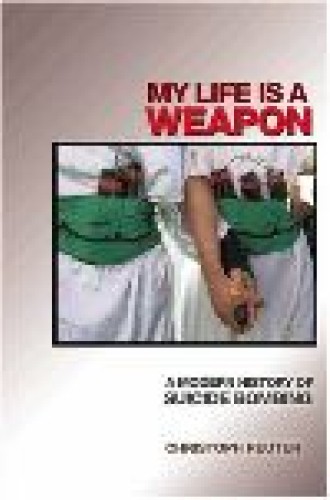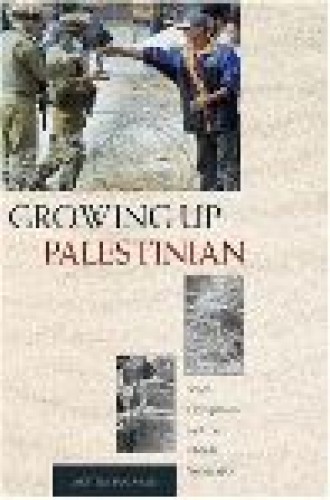My Life Is a Weapon/Growing Up Palestinian
Both of these books are about violence committed by Palestinians in particular and by Muslims in general. This is hardly a new topic to consumers of mainstream American media, which seem to notice these people only when they’re misbehaving. Both books, however, were originally published in 2002 for European audiences, Christoph Reuter’s as Mein Leben ist eine Waffe and Laetitia Bucaille’s as Générations Intifada. New to most American readers will be the humanizing personal stories of people living under repression and injustice. In short, these books show the violence that begets violence.
My first impression of Reuter’s history of suicide bombing was unfavorable. Having lived many months in Hebron with the Christian Peacemaker Teams, I began by looking up Baruch Goldstein in the index and found “murder of by mosque-goers.” Goldstein is the Brooklyn-born Israeli settler who, dressed in his military uniform, entered Hebron’s Ibrahimi mosque during Ramadan in 1994 and killed 29 Palestinian worshipers before he was beaten to death with a fire extinguisher. Israel’s response was to put the Palestinians of Hebron, but not the Israeli settlers, under total curfew. After the 40-day mourning period, the first Palestinian suicide bomber blew himself up inside Israel.
But that index entry is misleading. Reuter elsewhere describes Goldstein’s deed as “an act of savagery” and “the first serious setback for the hopes raised by the peace process.” The ensuing suicide bombing attacks within Israel were the stimulus for Reuter’s research into the phenomenon of individuals so willing to die for a cause that they “annihilate the entire logic of power, since no credible threat can be made against someone who has no desire to survive.”
This insightful, sensitively written book deserves a wide audience. Reuter, an international correspondent for the German magazine Stern, sees the genesis of the modern “culture of death” in Iran’s suicide battalions during the Iraq-Iran war. Inspired by the martyrdom of the Shi‘ite imam Hussein in Karbala in 680, tens of thousands of Iranian youths, most unarmed and some as young as 12, raced in “human wave attacks” into Iraqi military lines and minefields, willing to be slaughtered. Each had a key to paradise around his neck. This tactic of self-sacrifice was exported to the Shi‘ites of Lebanon, who used it to better cost-benefit effect when, on October 23, 1983, four suicide bombers forced American and French troops out of Lebanon.
Suicide bombing then spread to non-Shi‘ite Muslim groups: the Hindu Tamil Tigers in Sri Lanka (the country which has experienced the largest number of suicide attacks), the secular Kurdistan Workers Party in Turkey, and the mostly Sunni Muslim Palestinians, Chechen rebels and Iraqi resistance fighters. In each case, Reuter delineates the very real grievances of the communities involved: the first two are persecuted minorities, the last three are fighting for independence from occupying powers.
Reuter regards unresolved conflicts like these as fuel for al-Qaeda, a clandestine militant network that “derives sustenance from genuine, often well-founded local anger.” He describes al-Qaeda as a “parasite of anger” that operates “like McDonald’s: according to the franchise system.” Massive military reprisals only increase al-Qaeda’s appeal and are used to justify further suicide bombings. To wage war on terrorism is therefore not the solution. Reuter concludes with a quote from the Syrian-born poet Adonis: our war should be “against oppression and injustice, against the disregard for human rights and international law, and against poverty and ignorance.”
Bucaille, a French political scientist, devotes part of Growing Up Palestinian to vignettes of Palestinian lives, especially the lives of three young “militants” from Balata refugee camp in Nablus. All three spent most of their teen years in Israeli prisons and, upon release, were deported to Jordan. They returned home in the wake of the peace process, which they all supported, to find themselves targeted by the Israeli military. One was assassinated by an Israeli missile in 2001; the other two were arrested the following year and are still imprisoned in Israel.
The problematic part of Bucaille’s book is her social and political analysis, a risky endeavor in an area where events tend to overtake conclusions. She examines Palestinian society during the period of autonomy in seven West Bank cities and part of Gaza from 1994 to 2000, when the second intifada began. In 2001 Ariel Sharon was elected prime minister, and the following year the Israeli military reoccupied those areas. Some of Bucaille’s topics thus had become irrelevant even by the time of the book’s original French publication. She discusses as though they were going concerns the Gaza airport (closed by Israel in October 2000, then bombed) and the Jericho casino (destroyed in a November 2000 Israeli missile attack).
Her discussion of the Palestinian economy, which has now collapsed, is peculiar. After describing how Israel made Palestinians dependent on working within Israel, and then, in 1991, reversed its policy and opted for separation, replacing Palestinians with “guest workers” from Romania and Southeast Asia, she writes: “Israeli leaders tried to create conditions favorable to economic development in the Territories.” Favorable for whom? Bucaille points out that the construction sector within the territories grew by 8.7 percent between 1993 and 2000, with the number of Israeli settlers in the territories doubling and the many bypass roads built exclusively for Israelis. But Palestinian workers are often under curfew, and their movement is further restricted by Israeli military checkpoints and roadblocks. Incredibly, Bucaille describes this as “a real handicap to Israeli employers. . . . The existing Israeli and foreign workforce was insufficient to meet the demand.” Never mind skyrocketing Palestinian unemployment and the loss of Palestinian land expropriated for the new settlers and their roads.
Bucaille updated parts of her book for this 2004 English translation, but did so unevenly. In the process of responding to events, she apparently changed her mind about whom to blame for the Israeli-Palestinian impasse. Consequently, she repeatedly contradicts herself. For example, she claims that Israeli authorities “include the Palestinian Authority in policy-making decisions,” but accuses Israel of “the systematic demolition of anything that might embody the Palestinian Authority.” Another update may be needed.






